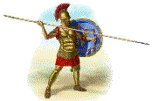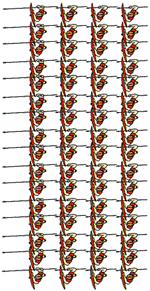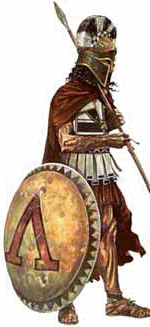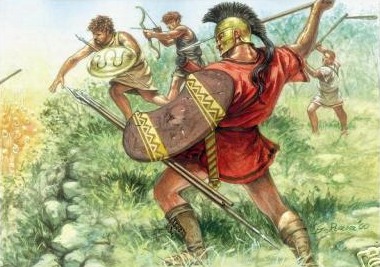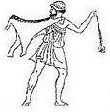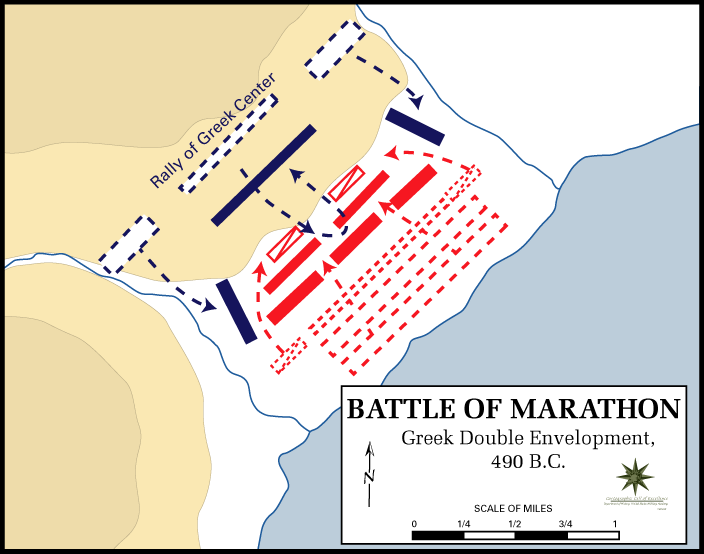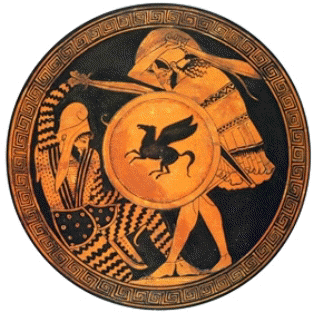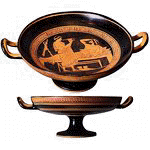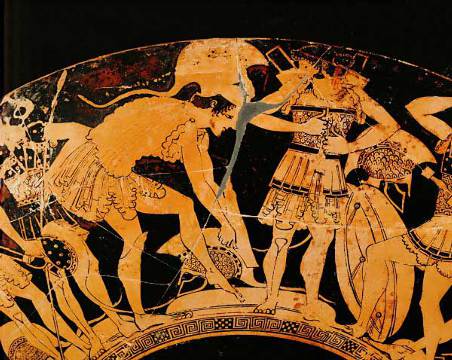
Below is an artist's impression of what could be young Athenian boys at school in Ancient Greece in the 5th Century B.C. This was during the famous Classical Period in Ancient Athens, and the Golden Age of Pericles. But it was also a time of ongoing warfare between the different City-States in Greece, and between the Greek States and the invading armies from the mighty Persian Empire. These young boys below, could well be wishing they were old enough to be ephebes, and out training with their older brothers. The ephebes, just like the young men in other Greek City-States, were learning the arts of war. They became skilled in weapons and warfare, so they could defend their City-State of Athens and protect their way of life. |
|
|
SOURCE A Citizens received military training during their service as ephebes from age 18 to 20: "The people elect two athletic trainers and instructors for them, to teach them their drill as heavy-armed soldiers and to use the bow, javelin, and sling.... They go on in this mode of life for the first year; in the following year an assembly is held in the theatre, and the ephebes give a display of drill before the people.
|
|
|
|
|
|
The Phalanx The Greeks started to fight as organized lines of battle called a phalanx. The first Greek author to use the word phalanx (φαλαγξ ) is Homer, and in his poems it means something like an organized battle line. The tactics must have been very simple. The heavily-armed soldiers, recruited from the upper class of a town (because only they could afford arms and panoply - armour), were standing in long, parallel lines, close to each other. Every hoplite carried a large round shield (the aspis or hoplon) which covered his own left side and the right side of the man to his left. A phalanx was, therefore, very densely packed and could not easily turn to the left or right. If its allowed to compare war with
sport: a hoplite battle was something like a "scrum" in a rugby match:
both sides, armed with spears, tried to push over the enemy, and once a
phalanx was victorious, the losses at the other side were extremely
heavy, because the victors would use their swords to kill the defeated
men. |


Behind them a boy plays the double aulos (flute).
| 1. If you were
a young Athenian ephebe in ancient Athens, what would have been
your activities and duties? (Include a few quoted words from (SOURCE A) to support your answer. Blend the quoted words into your own sentences.) |
The Men of Bronze Standing in a battle line and waiting for the clash with the enemy took considerable courage, as the Athenian playwright Euripides suggests in a diatribe against the demigod Heracles, who was...
... he is a man who has won a reputation for
valor in his contests with
beasts, but in all else is a weakling; who ne'er buckled shield to arm nor
faced the spear, but with a bow, that coward's weapon, was ever
ready to run away. Archery is no test of manly bravery; no! he is a
man who keeps his post in the ranks and steadily faces the swift
wound the spear may plough.
Wounds were likely, and therefore, the hoplites
wore armour. As well as wearing metal
helmets, they were protected by a breastplate,
greaves, their hoplon, and a tunic of stiffened linen.
Their offensive weapons were a spear and a
sword -
the latter only to be used in the second phase of the battle. The
soldiers must have been strong men, because the full panoply could weigh
as much as 15 kg, and it comes as no surprise that foreigners often
noted that the Greek soldiers were "men of bronze" (Herodotus,
Histories,
2.152) |
|
|
|
|
|||||||
|
The traditional tactics The normal practice of the Greeks, such as the Athenians and the Spartans, was to establish their heavily armed infantry in a solid mass, or phalanx, some eight to twelve men deep. ...The infantry would advance together so that the attack flowed unbroken against their enemy. In order to combat the phalanx's infamous right-hand drift ... [because the men on the right would bring their shield across to cover their unprotected right side, and then the man next to him would move across to keep behind the shield that should protect and overlap him from his right.] Greek commanders traditionally placed their most experienced, highly regarded and, generally, deadliest troops on the right wing as this was the place of honour. By contrast, the shakiest and/or least influential troops
were often placed on the left wing. In the Spartan battle plan
therefore, the
hippeis (an elite force numbering 300 men) and the king of
Sparta would stand on the right wing of the phalanx. The commonest phalanx tactic was
a simple advance to contact. Thucydides described the advance of
the two armies at Mantinea: |
||||||
|
|||||||
 Thracian peltast soldier. |
The Skirmishers Not every Greek warrior was a hoplite, and though often neglected, Greek armies were usually accompanied by other troop types. Light infantry and cavalry troops were used as skirmishers and to protect the vulnerable flanks of the ponderous phalanxes. [Mounted troops at the time though did not use saddles with stirrups, so there is some debate about how effective they would have been.] Javelin throwers called peltasts would be used as skirmishers, harassing enemy formations and masking troop movements behind them. They were armed with several javelins. Peltast warfare was developed in Thrace while the Greeks were developing an heavy infantry almost exclusively. This led to many of the light infantry troops from the outlying regions of Greece, being hired as mercenary troops. From: http://www.ancientmilitary.com/greek-warriors.htm Skirmishers also carried bows, javelins, slings, and sometimes carried light shields. Acting as light infantry with their light arms and minimal armour, they could run ahead of the main battle line, release a volley of arrows, slingshots or javelins, and retreat behind their main battle line, before the clash of the opposing main forces. The aims of skirmishing were to disrupt enemy formations by causing casualties before the main battle, and to tempt the opposing infantry into attacking prematurely, throwing their organization into disarray. Skirmishers could also be effectively used to surround opposing soldiers in the absence of friendly cavalry.
In classical Greece,
skirmishers had low status. For example,
Herodotus, in his account of the
Battle of Plataea of
479 BC, in the wars against Persia, mentions that the
Spartans fielded 35,000 light armed
helots (slaves) to 5,000
hoplites yet there is no mention of the skirmishers
fighting. Often Greek historians ignored them
altogether. It was far cheaper to equip oneself as light
armed as opposed to a fully armed hoplite – indeed it
was not uncommon for light armed to go into battle
equipped with stones. Hence the low status of
skirmishers reflected the low status of the poorer
sections of society who made up skirmishers.
From: http://en.wikipedia.org/wiki/Skirmisher |
||||||
|
|
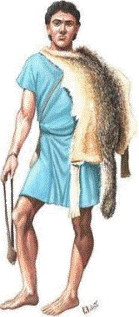 |
|
|
||||
|
|
|||
 |
|
|
|
|||
|
In the battle
plan above, you can see how the Athenians put their best
and strongest forces, not in the centre of their attack as was
the traditional strategy,. Instead, the Athenians put their
strongest forces on the wings, on the flanks. This resulted in
the Persians (red) moving quickly in disarray through the centre of
the Greek force, only to be attacked with the surprising
strength of the Greek forces from the sides. The Persians, in
confusion and panic, fled back to their ships. Another important factor in the Greek success, was their well thought-out panoply of armour, that greatly protected the Greeks, compared to the lack of armour and protective clothing worn by the Persian forces. |
||||
SOURCE G Herodotus described the dress of the Persian soldiers:
|
SOURCE H Herodotus later in comments about the Battle of Plataea, noted that
|
|
||||
|
|
|
|
||
| SOURCE I Well known red figure vase paintings from the time, that show the detail of the armour used by the Athenians and the lack of armour used by the Persian soldiers. |

| 10.
Your Own Command: Enlarge, scroll around
and study the features in the following picture. It is a picture of the terrain at the side of a valley where an ancient battle is about to be fought! You are in command of 40 Athenian Hoplites and 20 skirmishers. (Of your skirmishers, 5 are Thracian Peltast mercenaries, 4 are mounted cavalry with javelins, 6 have slings, and 5 carry bows.)
Your forces are at present moving in an Easterly direction
through the trees, towards position A seen in the above picture.
Group Work Option: Complete this task in groups of four
or five. Then present your war plans to the class and explain
the strategies and tactics you propose. Use
Power Point
(No.7)
or Prezi
(No.24)
to aid your presentation.
|
